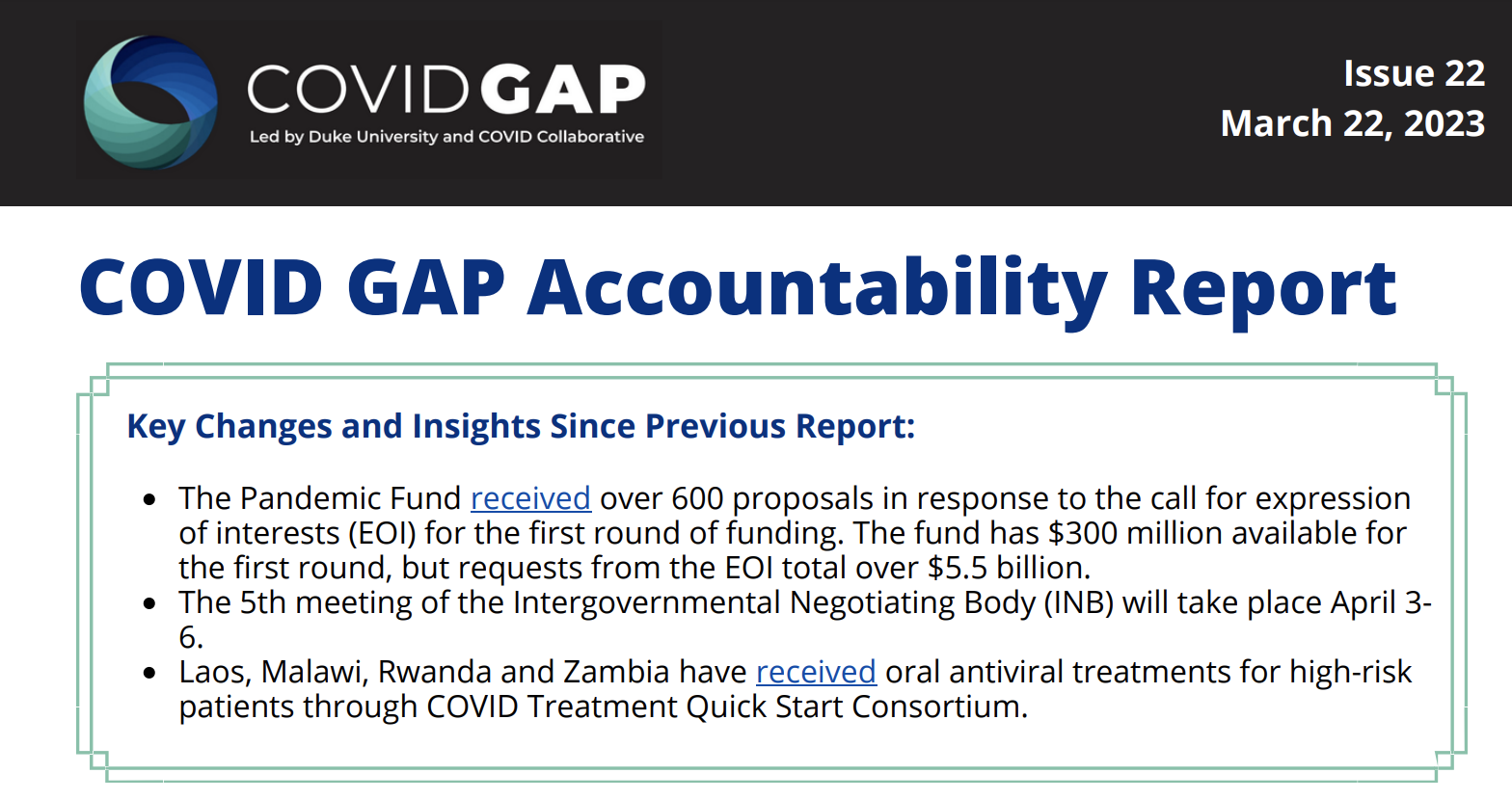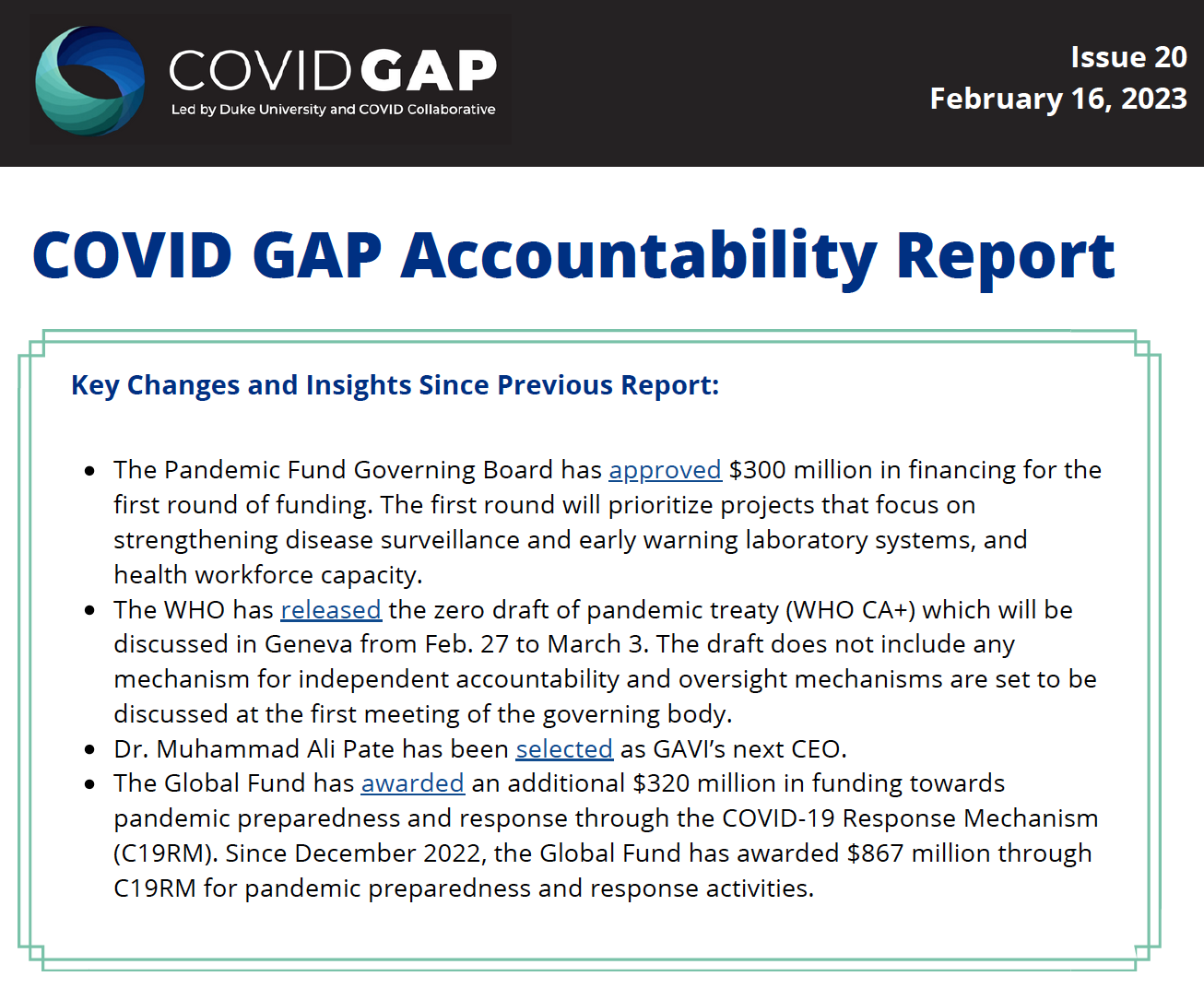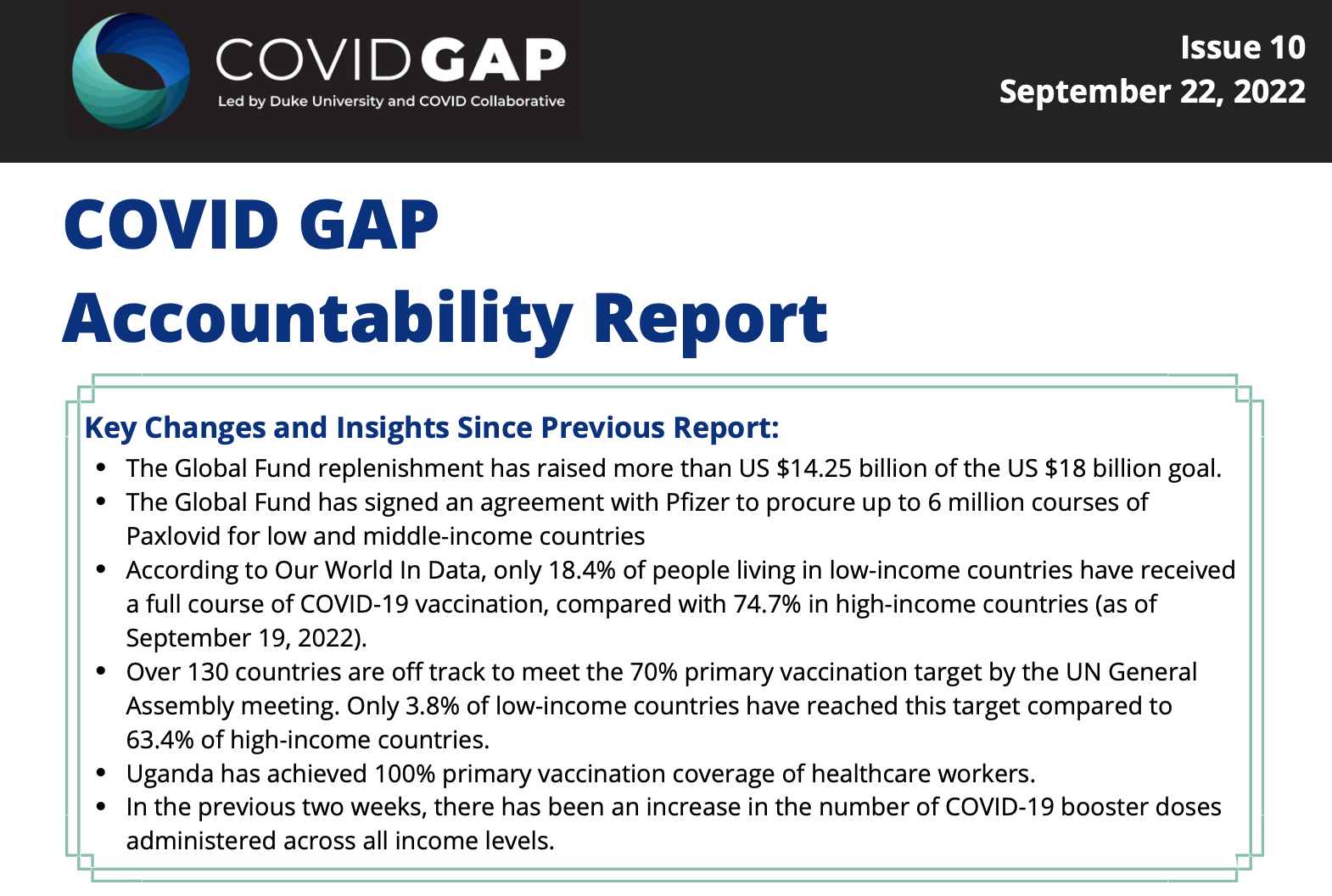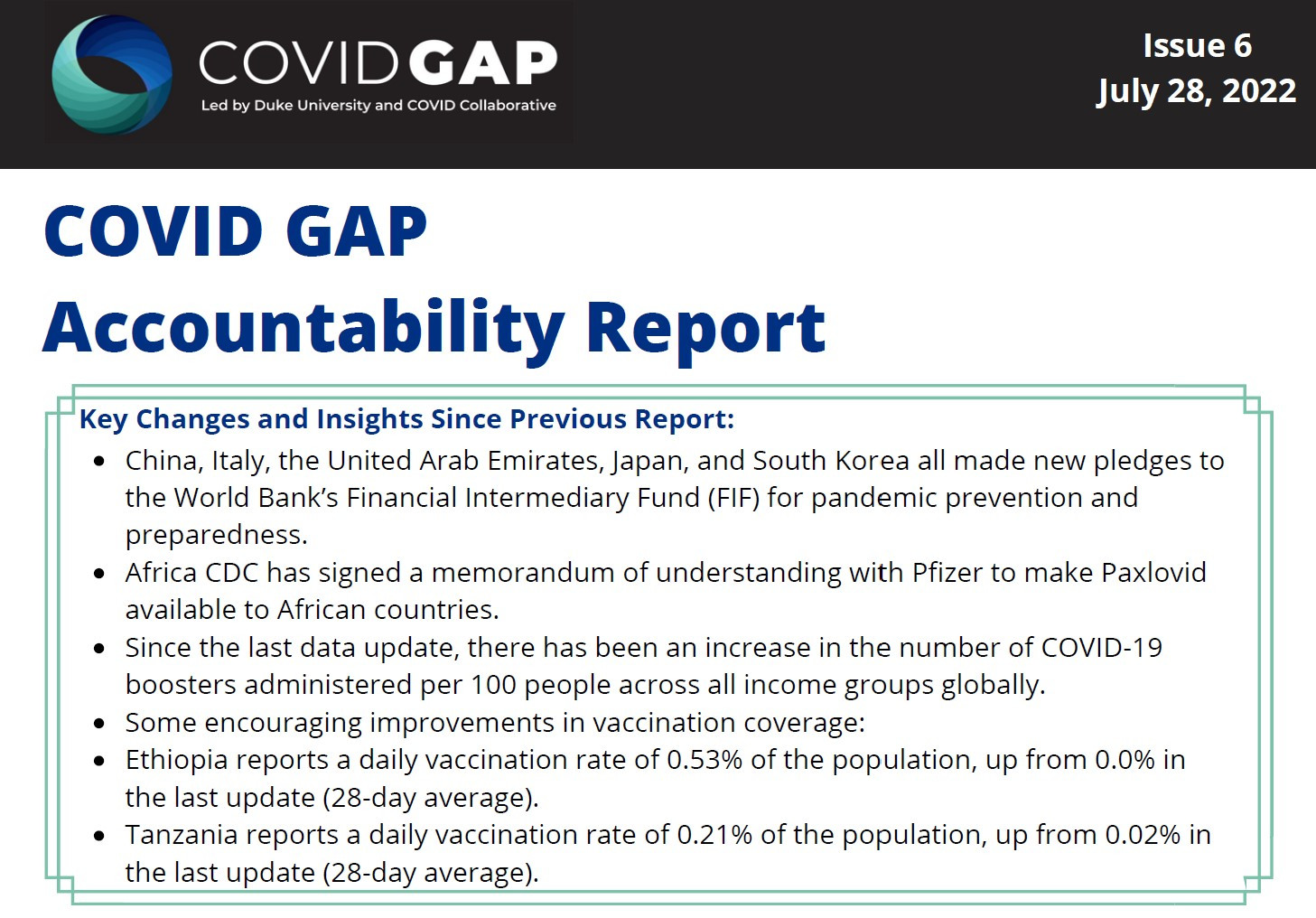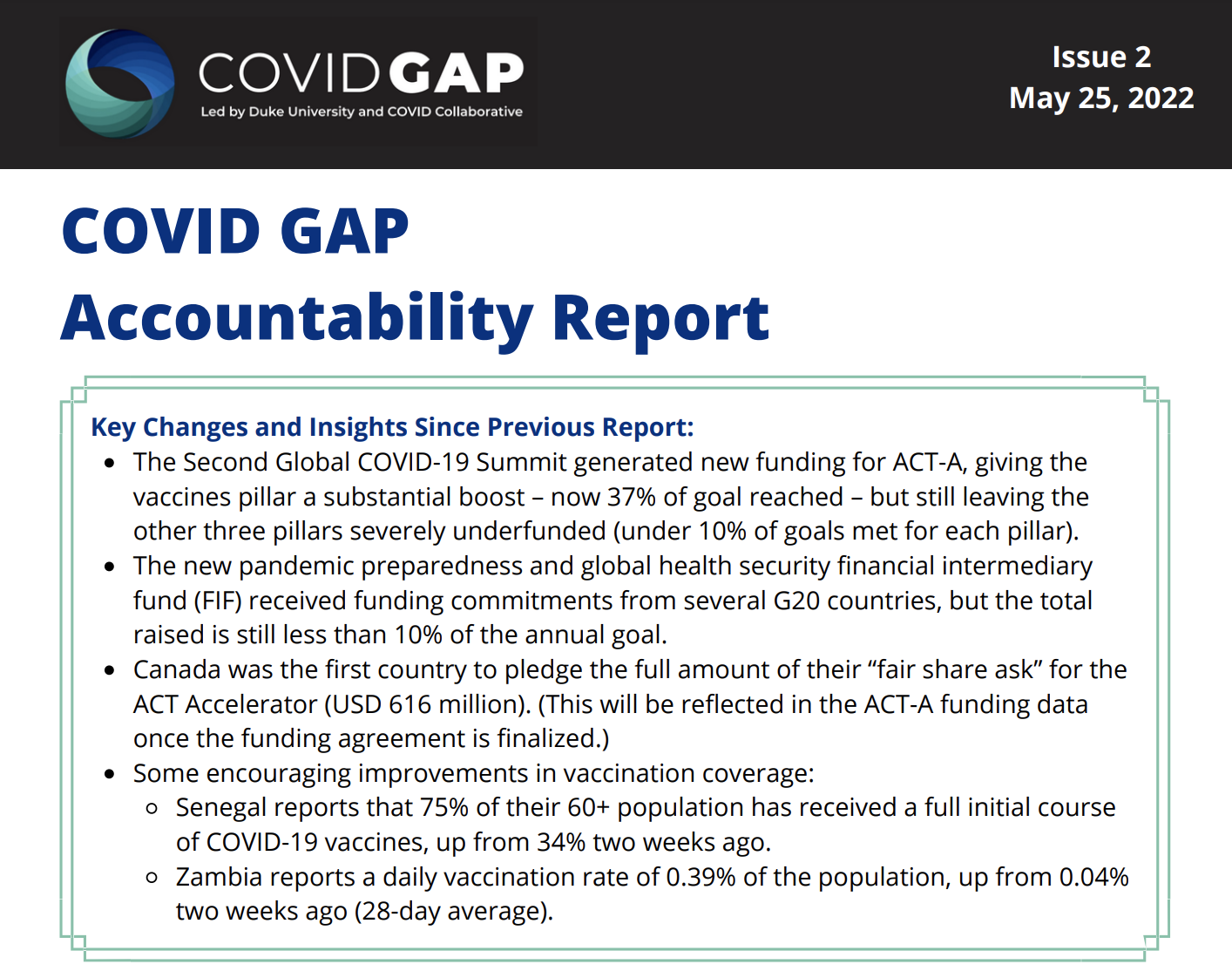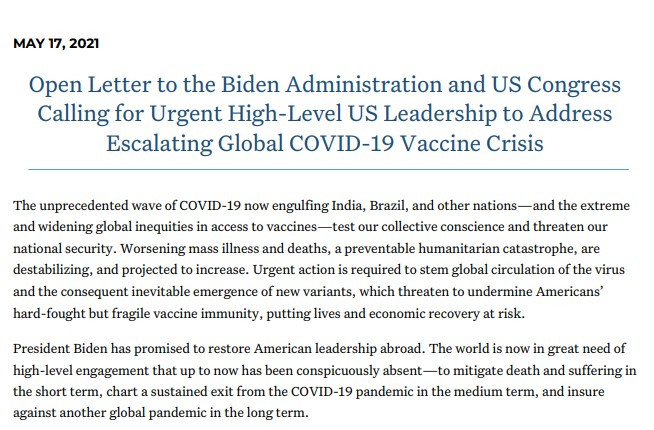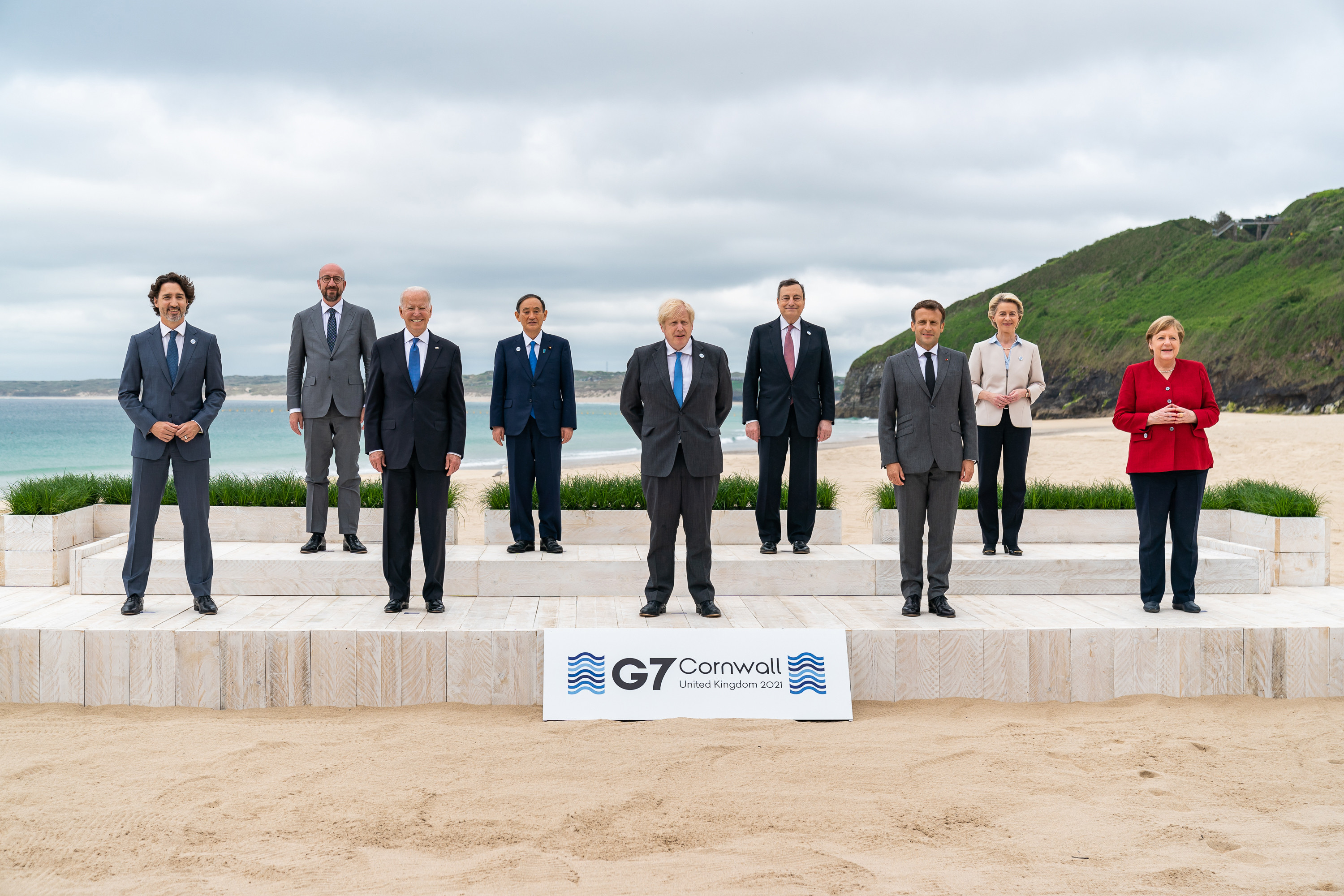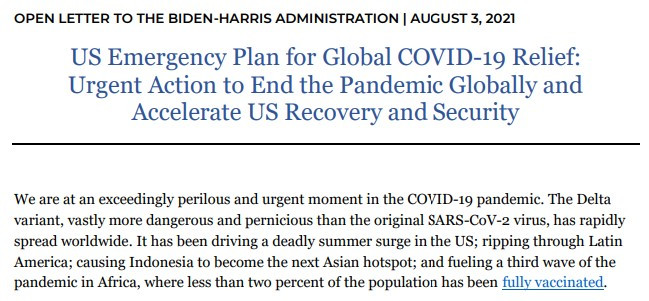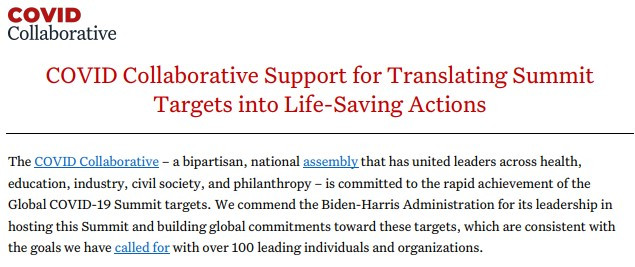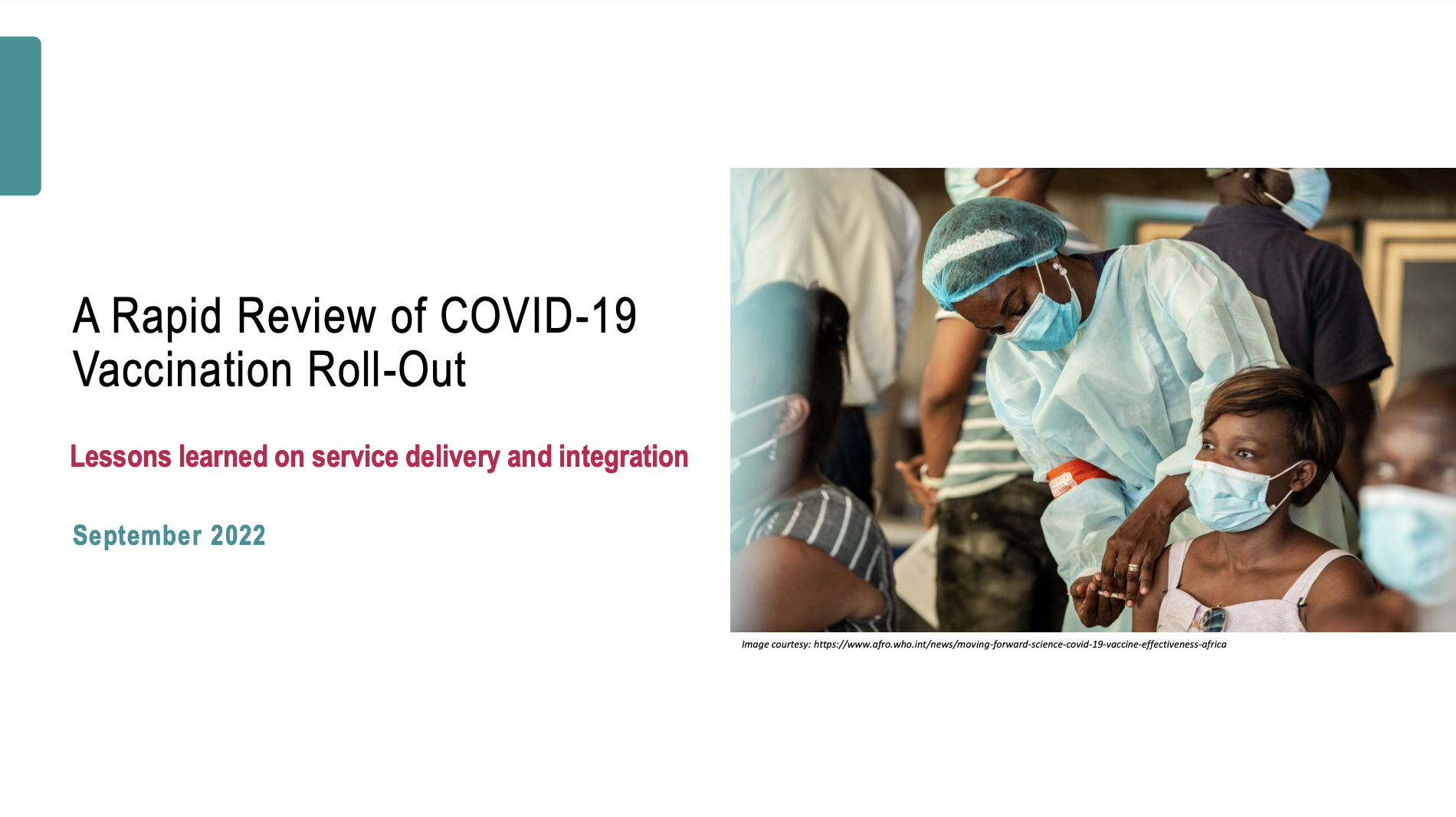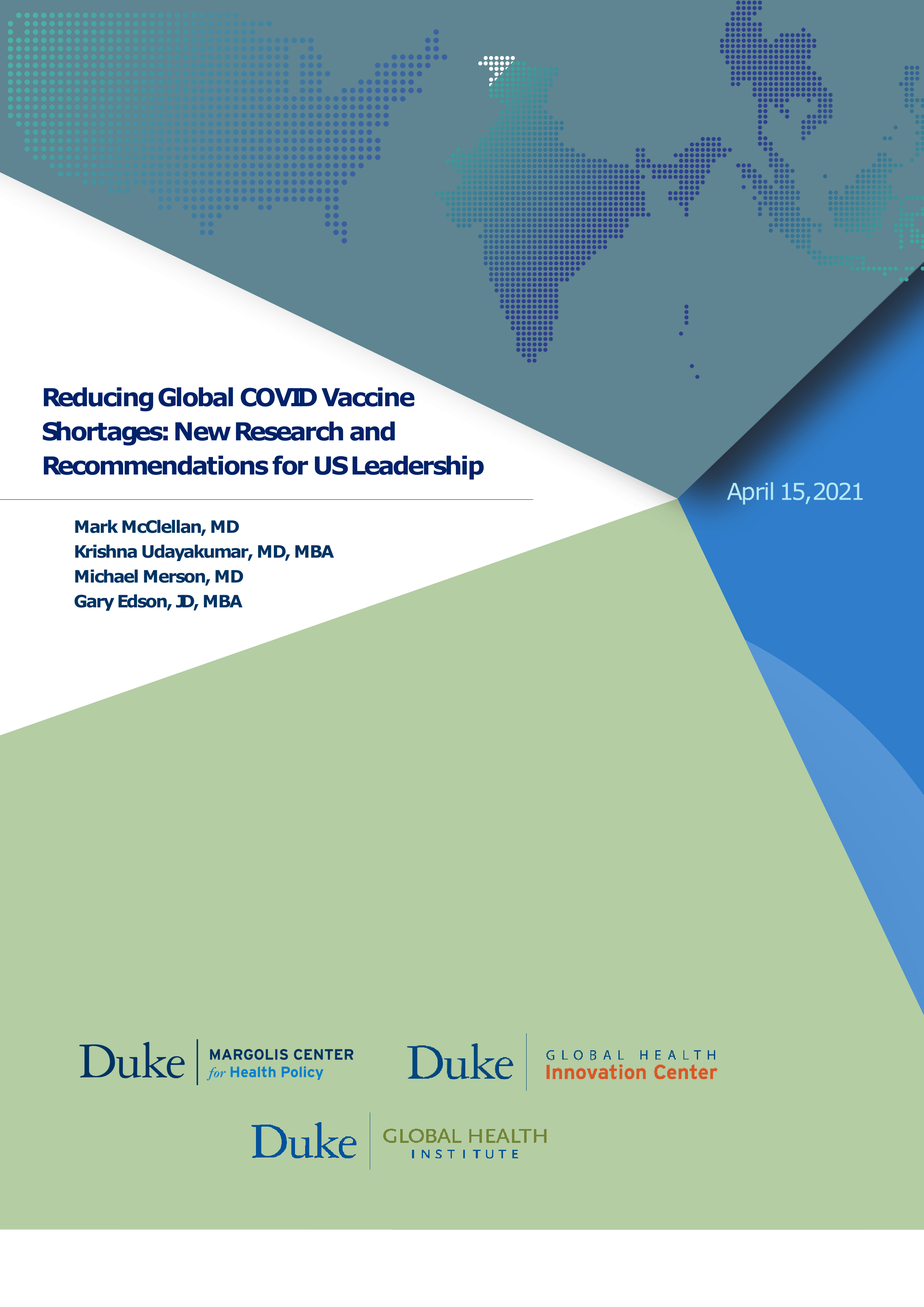
Papers, Publications, & Other Resources
May 11, 2023: Experiences, Enablers, and Challenges in Service Delivery and Integration of COVID-19 Vaccines: a Rapid Systematic Review
Abstract: The COVID-19 vaccination is a crucial public health intervention for controlling the spread and severity of the SARS-CoV2 virus. COVID-19 vaccines have been developed in record time, but their deployment has varied across countries, owing to differences in health system capacity, demand for the vaccine, and purchasing power of countries. The aim of this rapid review is to summarize and synthesize experiences on COVID-19 vaccine service delivery and integration to inform future COVID-19 vaccination programming and contribute to the knowledge base for future pandemic management. a systematic search was conducted in PubMed, Scopus, and Global Index Medicus databases. Twenty-five studies were included in the analysis. Included studies spanned nine countries where COVID-19 vaccines were delivered through mass, mobile, and fixed-post vaccination service delivery models. There was limited evidence of integrating COVID-19 vaccines into routine services for pregnant women, people who inject drugs, and leveraging existing health programs to deliver COVID-19 vaccines to the general population. Common challenges reported were vaccine skepticism, lack of adequate health workers, and linguistic barriers to access. Partnerships with a variety of stakeholders and the involvement of volunteers were vital in overcoming barriers and contributed to the efficient functioning of COVID-19 vaccination programs.
April 19, 2023: COVID GAP Accountability Report Issue 24
April 19, 2023: COVID GAP Accountability Report Issue 24
Key Changes and Insights Since Previous Report:
On April 17th, India reported over 9,000 new COVID-19 cases prompting some parts of the country to reintroduce mask mandates.
The XBB.1.16 variant now accounts for roughly 7.2% of sequenced COVID-19 cases in the United States.
The World Health Organization’s technical advisory group on COVID vaccine composition met in March to review the performance of updated COVID-19 vaccines. The group released a statement saying that the updated vaccines that contain either BA.1 or BA.4/5 provide better protection than vaccines that contain only the original virus.
The FDA authorized a second bivalent COVID-19 vaccine for seniors ages 65+ and those with compromised immune systems.
April 5, 2023: COVID GAP Accountability Report Issue 23
April 5, 2023: COVID GAP Accountability Report Issue 23
Key Changes and Insights Since Previous Report:
India reported over 3,600 new COVID-19 cases on April 3rd. This represents the largest single day increase in new cases in over 6 months.
The World Health Organization is monitoring the XBB.1.16 subvariant that is currently circulating in India.
The European Medicines Agency (EMA) and the Committee for Medicinal Products for Human Use (CHMP) have authorized the use of Bimervax as a COVID-19 booster vaccine. Bimervax is a bivalent, recombinant protein vaccine.
South Korea plans to start using wastewater surveillance to monitor the spread of COVID-19 in the country.
The health systems and response pillar of ACT-A has received $10 million in additional funding, and is now 35.9% funded.
Botswana has achieved 70% vaccination coverage.

March 22, 2023: COVID GAP Accountability Report Issue 22
March 22, 2023: COVID GAP Accountability Report Issue 22
Key Changes and Insights Since Previous Report:
The Pandemic Fund received over 600 proposals in response to the call for expression of interests (EOI) for the first round of funding. The fund has $300 million available for the first round, but requests from the EOI total over $5.5 billion.
The 5th meeting of the Intergovernmental Negotiating Body (INB) will take place April 3- 6.
Laos, Malawi, Rwanda and Zambia have received oral antiviral treatments for high-risk patients through COVID Treatment Quick Start Consortium.
March 1, 2023: COVID GAP Accountability Report Issue 21
March 1, 2023: COVID GAP Accountability Report Issue 21
Key Changes and Insights Since Previous Report:
The Pandemic Fund closed their call for expressions of interest on February 24th. The first call for proposals is expected to be announced in early March and applicants will have 11 weeks to submit proposals. The Governing Board plans to make funding decisions in July 2023.
The Global Preparedness Monitoring Board has released a document outlining 3 tests to ensure the success of key pandemic prevention, preparedness, and response reforms.
The fourth meeting of the WHO Intergovernmental Negotiating Body will run from February 27th to March 3rd. Discussion will focus on the zero draft of the Pandemic Treaty.
Dr. Jean Kaseya has been selected as the first Director General of the Africa Centers for Disease Control.
David Malpass, President of the World Bank, has announced he plans to step down on June 30th after serving for 4 years. The United States has nominated Ajay Banga to serve as the next President.
The U.S. FDA recently authorized the first over-the-counter test that detects both COVID-19 and Influenza A and B.
A new nasal COVID-19 vaccine has been shown to reduce the risk of symptomatic COVID-19 cases by 86% in a recent phase 1 clinical trial.
The Africa Centers for Disease Control has released its first risk-ranking and prioritization of epidemic-prone diseases. Ebola, Cholera, and COVID-19 were found to have the highest epidemic potential.
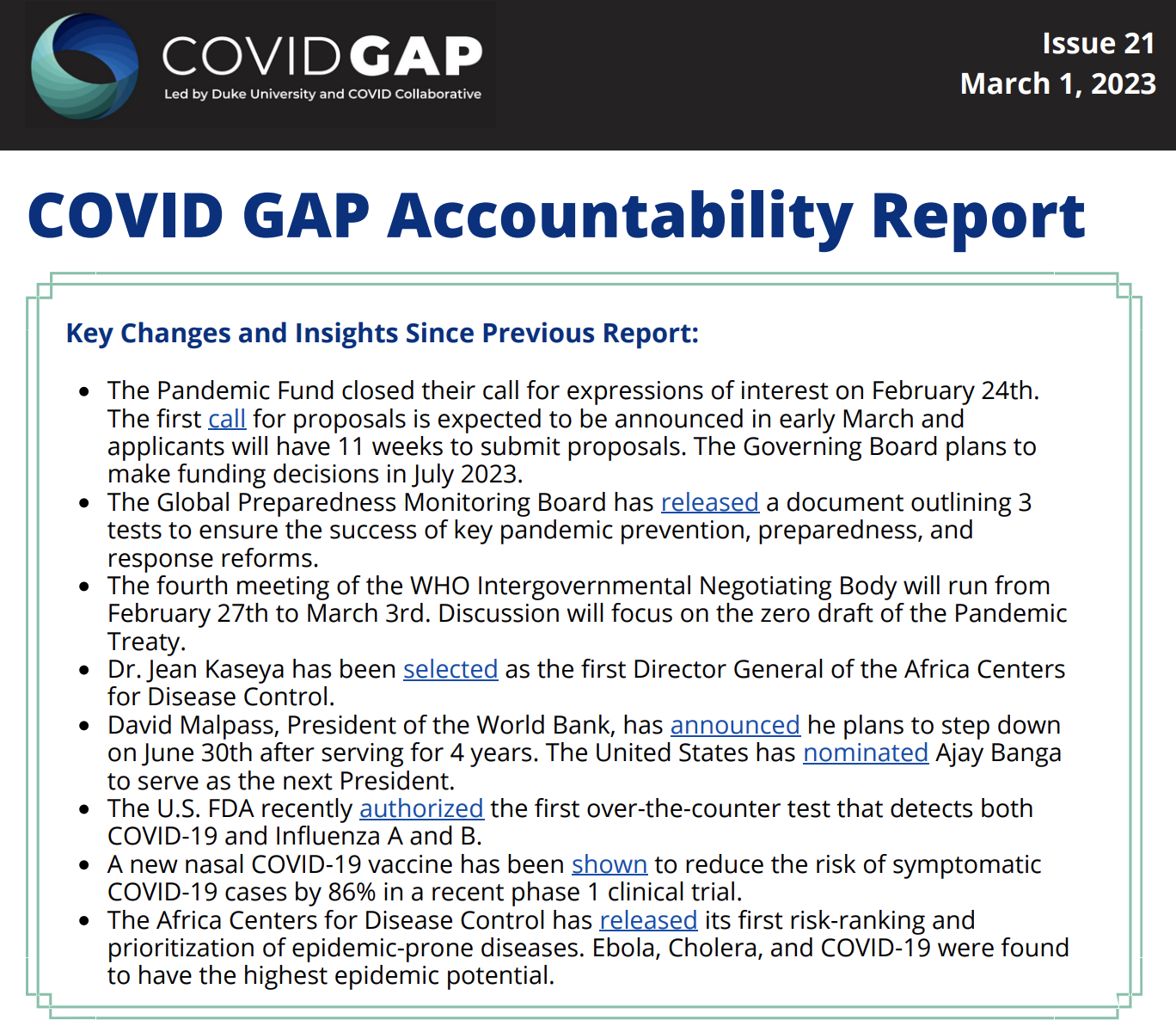
February 16, 2023: COVID GAP Accountability Report Issue 20
February 16, 2023: COVID GAP Accountability Report Issue 20
Key Changes and Insights Since Previous Report:
The Pandemic Fund Governing Board has approved $300 million in financing for the first round of funding. The first round will prioritize projects that focus on strengthening disease surveillance and early warning laboratory systems, and health workforce capacity.
The WHO has released the zero draft of pandemic treaty (WHO CA+) which will be discussed in Geneva from Feb. 27 to March 3. The draft does not include any mechanism for independent accountability and oversight mechanisms are set to be discussed at the first meeting of the governing body.
Dr. Muhammad Ali Pate has been selected as GAVI’s next CEO.
The Global Fund has awarded an additional $320 million in funding towards pandemic preparedness and response through the COVID-19 Response Mechanism (C19RM). Since December 2022, the Global Fund has awarded $867 million through C19RM for pandemic preparedness and response activities.
February 2, 2023: COVID GAP Accountability Report Issue 19
February 2, 2023: COVID GAP Accountability Report Issue 19
Key Changes and Insights Since Previous Report:
Chad is reporting a 0.30% daily vaccination rate (28-day average) which is an increase from 0.00% in the previous report. Chad is reporting 100% vaccination coverage of the 60+ population, which is an increase from 78.37% two weeks ago.
Tanzania is reporting that 68.77% of the healthcare worker population has been vaccinated which is an increase from 40.73%. Tanzania is also reporting 100% vaccination coverage of the 60+ population, an increase from 9.90% in the previous report.
Uganda is reporting that 100% of the 60+ population has been vaccinated, an increase from 36.19% in the previous report.
The number of booster doses administered per 100 people has increased slowly across all income levels as follows:
High income increased to 47.39 from 47.31
Upper middle income increased to 24.70 from 24.64
Lower middle income increased to 17.76 from 17.55
Low income increased to 3.56 from 3.29
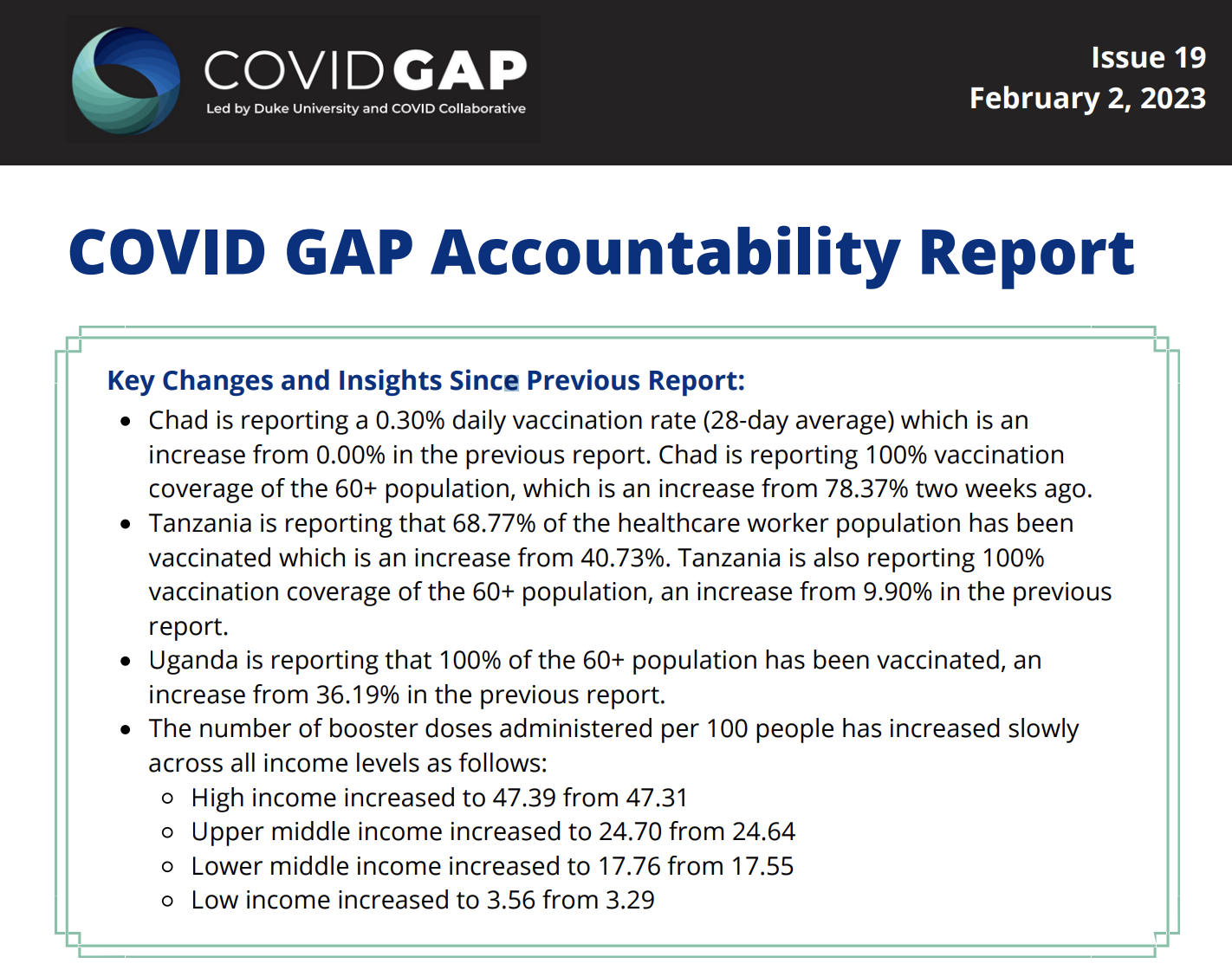
January 19, 2023: COVID GAP Accountability Report Issue 18
January 19, 2023: COVID GAP Accountability Report Issue 18
Key Changes and Insights Since Previous Report:
The number of booster doses administered per 100 people has increased across all income levels as follows:
High income increased to 47.31 from 47.21
Upper middle income increased to 24.64 from 24.46
Lower middle income increased to 17.55 from 17.36
Low income increased to 3.29 from 2.98
Nigeria is reporting 71.01% vaccination coverage of the 60+ population, which is an increase from 65.98% two weeks ago.
South Sudan is reporting 53.95% vaccination coverage of the 60+ population, which is an increase from 51% two weeks ago.
Sierra Leone is reporting a 0.27% daily vaccination rate (28-day average), an increase from 0.18% in the previous report.
Malawi is reporting a 0.08% daily vaccination rate (28-day average), an increase from 0.03% in the previous report.
January 5, 2023: COVID GAP Accountability Report Issue 17
January 5, 2023: COVID GAP Accountability Report Issue 17
Key Changes and Insights Since Previous Report:
China has rolled back its zero-COVID policies, and there is a lack of accurate data available regarding COVID deaths or circulating variants. Airfinity’s model predicts there will be 1.7 million deaths by the end of April 2023.
Amidst the COVID-19 surge in China, several countries have implemented travel requirements for travelers coming from China. The U.S. and U.K. are requiring pre-flight COVID tests while Morocco is implementing a full entry ban.
Singapore announced a pledge of USD $1 million to the Global Fund.
Nigeria is reporting 65.98% vaccination coverage of their 60+ population which is an increase from 56.49% two weeks ago.
The Democratic Republic of the Congo is reporting 81.92% vaccination coverage of their healthcare worker population which is an increase from 59.31% two weeks ago.
The average daily testing rates have decreased across all income groups.

December 14, 2022: COVID GAP Accountability Report Issue 16
December 14, 2022: COVID GAP Accountability Report Issue 16
Key Changes and Insights Since Previous Report:
India has announced a pledge of USD $25 million to the Global Fund.
Xocova (ensitrelvir), the newest oral antiviral on the market, received emergency regulatory approval and distribution has begun in Japan.
The Central African Republic reports a daily vaccination rate (28-day average) of 0.23%, an increase from 0.04% two weeks ago.
Cameroon is reporting 23.75% vaccination coverage of their 60+ population which is an increase from 13.33% two weeks ago.
Burkina Faso is reporting 72.61% vaccination coverage of their healthcare worker population which is an increase from 66.29% two weeks ago.
November 30, 2022: COVID GAP Accountability Report Issue 15
November 30, 2022: COVID GAP Accountability Report Issue 15
Key Changes and Insights Since Previous Report:
Chad reports 100% primary vaccination coverage of the healthcare worker population which is an increase from 30.1% two weeks ago. Chad also reports 78.33% primary vaccination coverage of the 60+ population, an increase from 3.33%.
Afghanistan reports 32.58% primary vaccination coverage of the healthcare worker population which is an increase from 9% in the previous report.
The number of booster doses administered per 100 people has increased across all income levels.
The average number of daily tests per 1,000 people has increased in quarter 4 across high income, upper-middle income, and lower-middle income countries.

November 16, 2022: COVID GAP Accountability Report Issue 14
November 16, 2022: COVID GAP Accountability Report Issue 14
Key Changes and Insights Since Previous Report:
On November 13th, the G20 officially launched the pandemic prevention, preparedness, and response financial intermediary fund – now called the Pandemic Fund.
Italy and the United Kingdom have announced their pledges towards the Global Fund replenishment. Italy pledges 185 million euros and the United Kingdom pledges 1 billion GBP.
Both the vaccination pillar and health systems and response pillar of ACT-A have received additional contributions, reaching 71.5% and 10.5% of the target funding respectively.
Germany pledged an additional $97.84 million to CEPI while Mexico and BMGF have contributed the full amount pledged.
Niger reports a daily vaccination rate (28-day average) of 0.32%, an increase from 0% two weeks ago.
Côte d’Ivoire is reporting 70.10% vaccination coverage of their 60+ population which is an increase from 46.73% two weeks ago.
November 3, 2022: COVID GAP Accountability Report Issue 13
November 3, 2022: COVID GAP Accountability Report Issue 13
Key Changes and Insights Since Previous Report:
The ACT-Accelerator transition plan has been released. From October 2022 to March 2023, ACT-A will support countries in transitioning to long-term COVID-19 control across three overarching areas: research and development and market shaping activities, securing institutional arrangements for sustained access to COVID-19 tools, and concentrating in-country work on new product introductions and protection of priority populations.
Zambia reports a daily vaccination rate (28-day average) of 0.34%, an increase from 0.07% two weeks ago.
The number of booster doses administered per 100 people has increased across all income levels except for lower middle-income countries.
New: COVID GAP is now tracking purchases of bivalent COVID-19 vaccines.
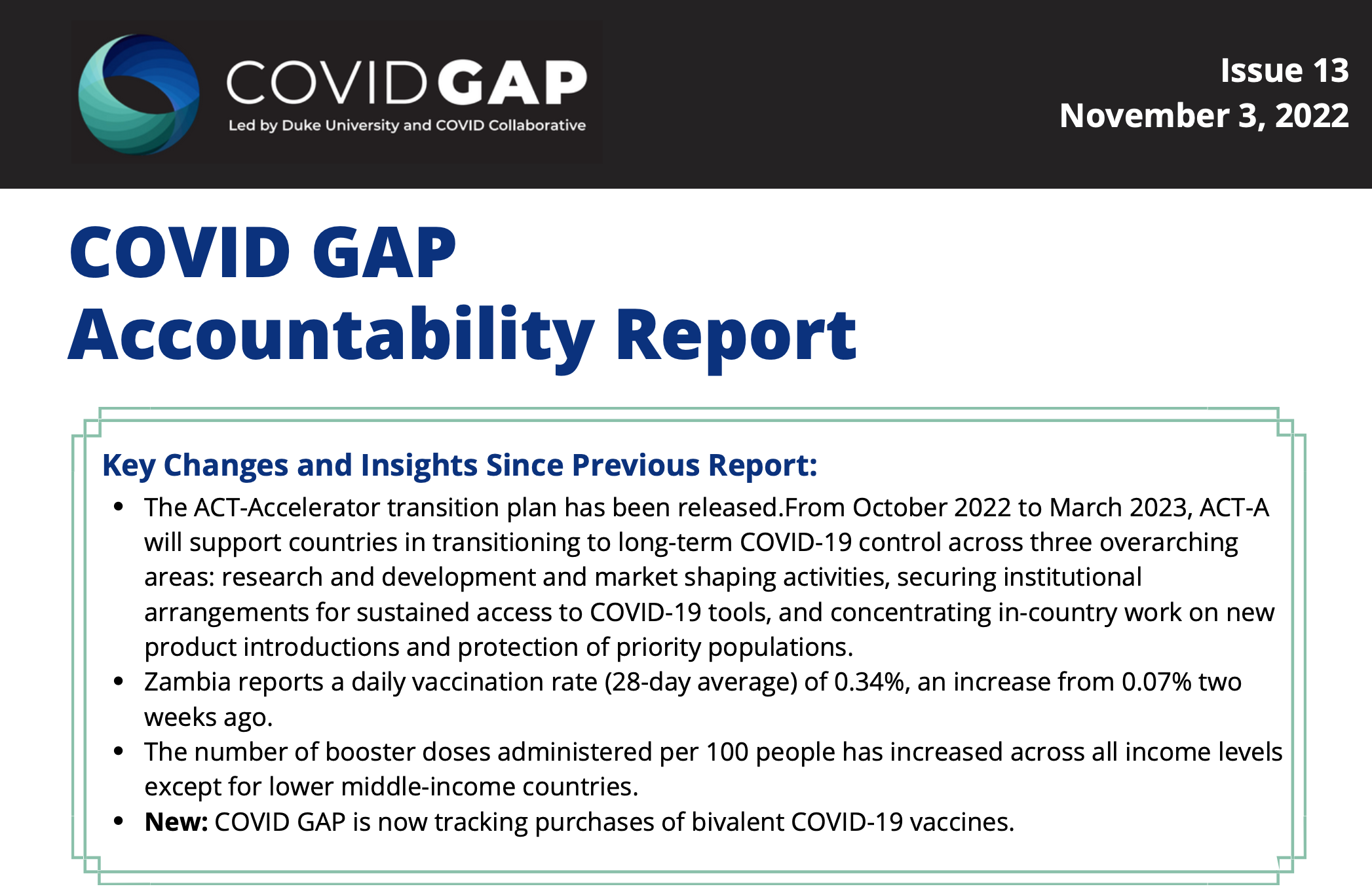
October 19, 2022: COVID GAP Accountability Report Issue 12
October 19, 2022: COVID GAP Accountability Report Issue 12
Key Changes and Insights Since Previous Report:
Findings from the ACT-A external evaluation have been released. The ACT-A Facilitation Council commissioned Open Consultants to evaluate ACT-A experiences and identify key lessons learned for future pandemic preparedness and response.
Gavi and Moderna have signed an agreement to cancel the remaining volume of vaccine doses for 2022, and make available up to 100 million doses of variant containing vaccines for low and middle-income countries.
The Medicines Patent Pool has signed a license agreement with Shionogi & Co. for their oral antiviral candidate, ensitrelvir.
Somalia reports a daily vaccination rate (28-day average) of 0.47%, an increase from 0.23% two weeks ago.The number of booster doses administered per 100 people has increased in upper middle- income and lower middle-income countries.
October 5, 2022: COVID GAP Accountability Report Issue 11
October 5, 2022: COVID GAP Accountability Report Issue 11
Key Changes and Insights Since Previous Report:
Each ACT-A pillar has received additional funding, yet all remain underfunded as the ACT-A fiscal year ends.
Spain has contributed $16 million to the World Bank’s financial intermediary fund for pandemic prevention and preparedness.
Generic molnupiravir from Hetero Labs in India has received WHO prequalification.
The United States is decreasing the number of Pfizer COVID-19 vaccine doses it will purchase to donate to other countries from 1 billion to 600 million doses.
Senegal reports that 83.45% of their 60+ population has received a full course of COVID-19 vaccination, up from 35.88% two weeks ago.
Since the last data update, Somalia and Central African Republic have had the greatest changes in percent of the population fully vaccinated and daily vaccination rate, but still modest (e.g., less than 1% change in population fully vaccinated).
There has been an increase in the number of COVID-19 booster doses administered across all income levels in the last two weeks.
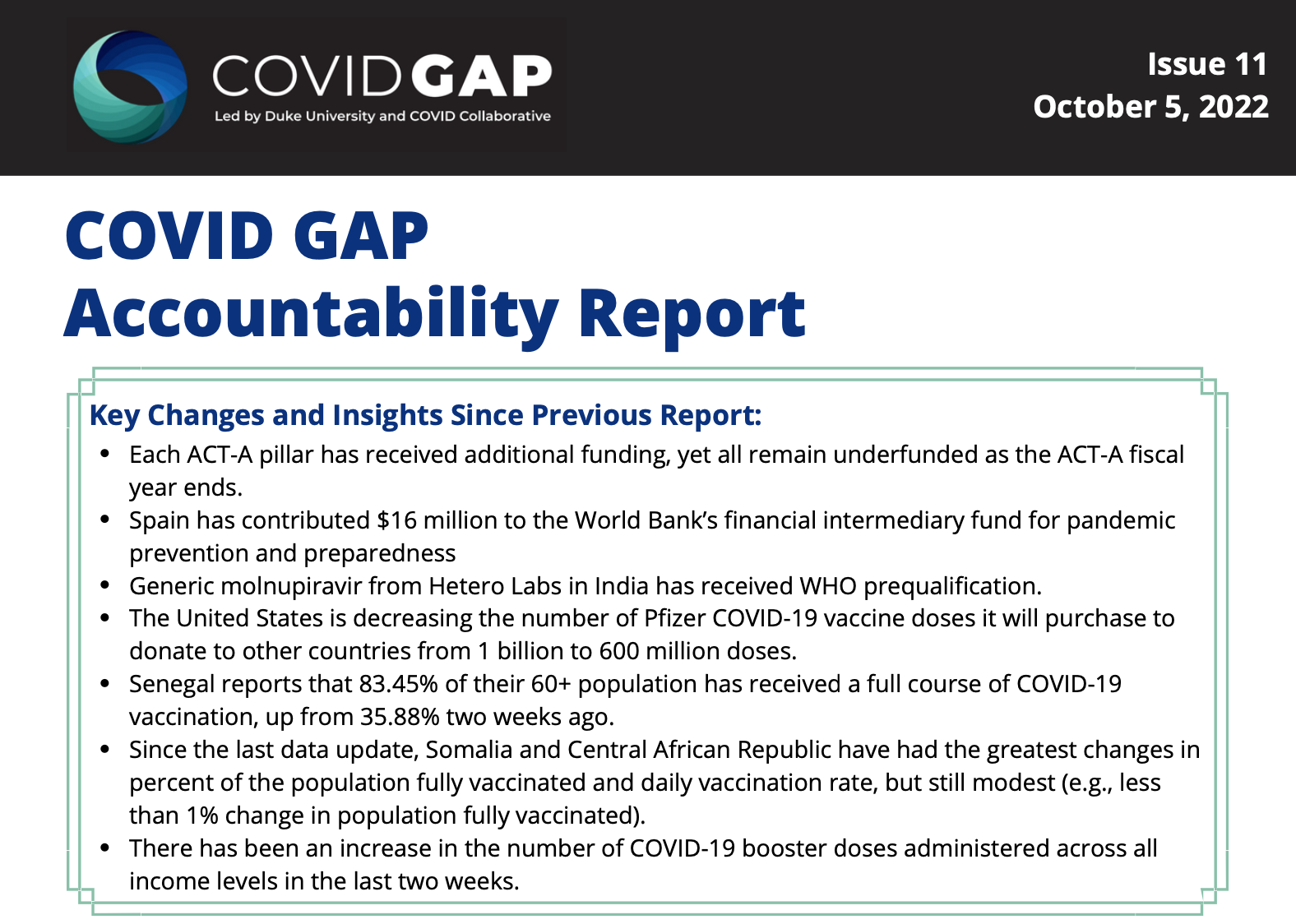
September 22, 2022: COVID GAP Accountability Report Issue 10
September 22, 2022: COVID GAP Accountability Report Issue 10
Key Changes and Insights Since Previous Report:
The Global Fund replenishment has raised more than US $14.25 billion of the US $18 billion goal.
The Global Fund has signed an agreement with Pfizer to procure up to 6 million courses of Paxlovid for low and middle-income countries
According to Our World In Data, only 18.4% of people living in low-income countries have received a full course of COVID-19 vaccination, compared with 74.7% in high-income countries (as of September 19, 2022).
Over 130 countries are off track to meet the 70% primary vaccination target by the UN General Assembly meeting. Only 3.8% of low-income countries have reached this target compared to 63.4% of high-income countries.
Uganda has achieved 100% primary vaccination coverage of healthcare workers.
In the previous two weeks, there has been an increase in the number of COVID-19 booster doses administered across all income levels.
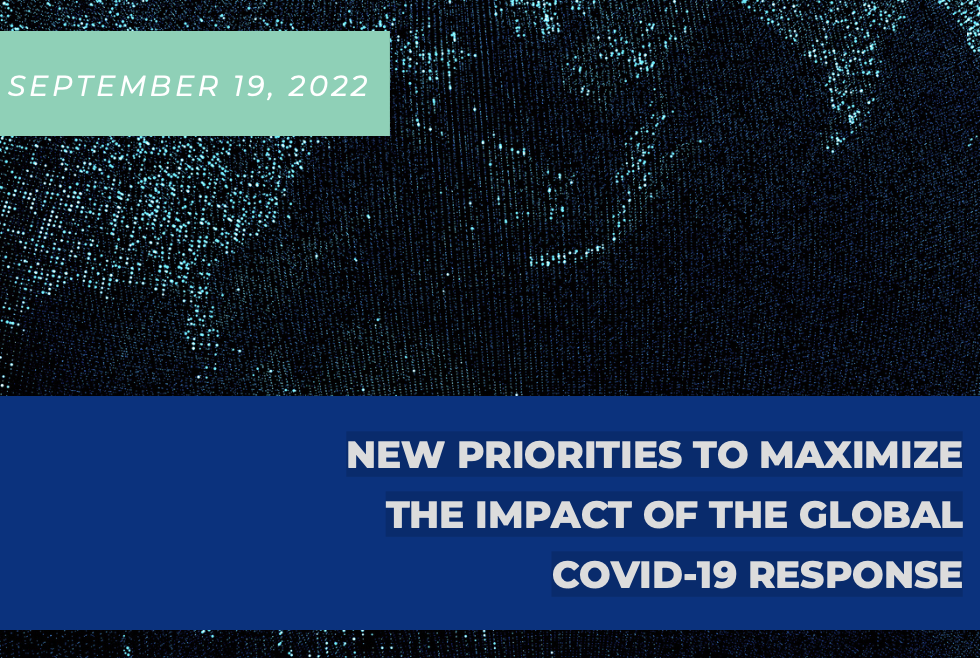
September 19, 2022: New Priorities to Maximize the Impact of the Global COVID-19 Response
Scientific advances have largely provided the tools to make COVID-19 a manageable global health security threat, if those tools are made available equitably around the world. As the COVID-19 response transitions out of emergency mode, scarce global dollars must be used effectively, efficiently, and equitably. The COVID Global Accountability Platform (COVID GAP) team offered recommendations to guide this critical transition over the coming months.
COVID GAP Accountability Report: September 2022
September 8, 2022: COVID GAP Accountability Report Issue 9
Key Changes and Insights Since Previous Report:
NEW: COVID GAP is now tracking booster doses administered globally in vulnerable populations (healthcare workers and those aged 60+).
The health systems and response pillar and the vaccination pillar of ACT-A have received additional funding and are now 9.7% and 69.7% funded, respectively.
South Sudan has achieved 100% vaccination coverage of healthcare workers.
Burkina Faso reports a daily vaccination rate of 0.13% of the population, an increase from 0.01% in the previous update.
Afghanistan has achieved 39.10% vaccination coverage of those aged 60+ compared to 19.73% two weeks ago.

COVID GAP Accountability Report: August 2022
August 24, 2022: COVID GAP Accountability Report Issue 8
Key Changes and Insights Since Previous Report:
New Zealand has contributed $1.26 million to the World Bank’s Financial Intermediary Fund (FIF) for pandemic preparedness and prevention.
The number of COVID-19 boosters administered per 100 people has increased across all income groups in the past two weeks.
South Sudan has achieved 95.75% vaccination coverage for healthcare workers, an increase from 77.83% two weeks ago.
Afghanistan reports a daily vaccination rate of 0.29% of the total population, an increase from 0.14% in the last update (28-day average).
August 11, 2022: COVID GAP Accountability Report Issue 7
Key Changes and Insights Since Previous Report:
The vaccination pillar of ACT-A has received additional contributions and is now 69.3% funded.
The European Commission has now contributed $326.5 million towards ACT-A, up from $260 million in the last update.
In the last two weeks, the average number of daily tests has increased across all income groups except for low-income.
In the last two weeks, there has been an increase in the number of COVID-19 boosters administered per 100 people across all income groups globally.
Tanzania reports a daily vaccination rate of 0.48% of the total population, up from 0.21% in the last update (28-day average).
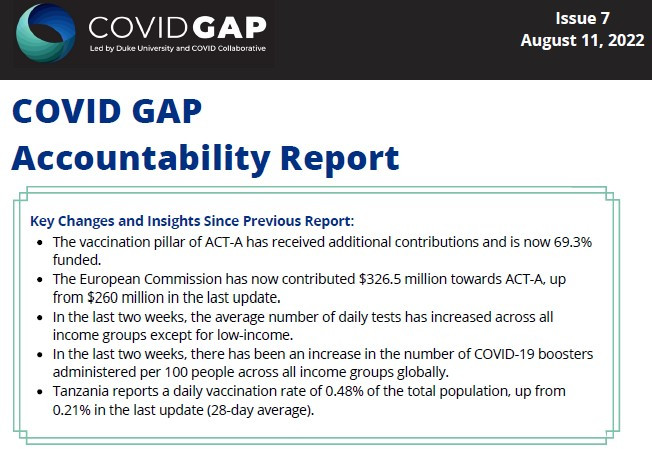
July 28, 2022: COVID GAP Accountability Report Issue 6
Key Changes and Insights Since Previous Report:
China, Italy, the United Arab Emirates, Japan, and South Korea all made new pledges to
the World Bank’s Financial Intermediary Fund (FIF) for pandemic prevention and preparedness.
Africa CDC has signed a memorandum of understanding with Pfizer to make Paxlovid available to African countries.
Since the last data update, there has been an increase in the number of COVID-19 boosters administered per 100 people across all income groups globally.
Some encouraging improvements in vaccination coverage:
Ethiopia reports a daily vaccination rate of 0.53% of the population, up from 0.0% in the last update (28-day average).
Tanzania reports a daily vaccination rate of 0.21% of the population, up from 0.02% in the last update (28-day average).
July 7, 2022: COVID GAP Accountability Report Issue 5
Key Changes and Insights Since Previous Report:
Last week, the World Bank approved the establishment of a new Financial Intermediary Fund (FIF) to finance investments to strengthen pandemic prevention, preparedness and response at national, regional, and global levels with a focus on low and middle-income countries. The goal is to launch the FIF in the fall.
Sweden has now contributed 124% of its ACT-A “fair share” (US $300 million).
The vaccination pillar of ACT-A now has an additional $1.8 billion in contributions, bringing the pillar from 39.5% funded to 69.1% funded.
Since the last data update, there has been an increase in the number of COVID-19 boosters administered per 100 people across all income groups except for low income.
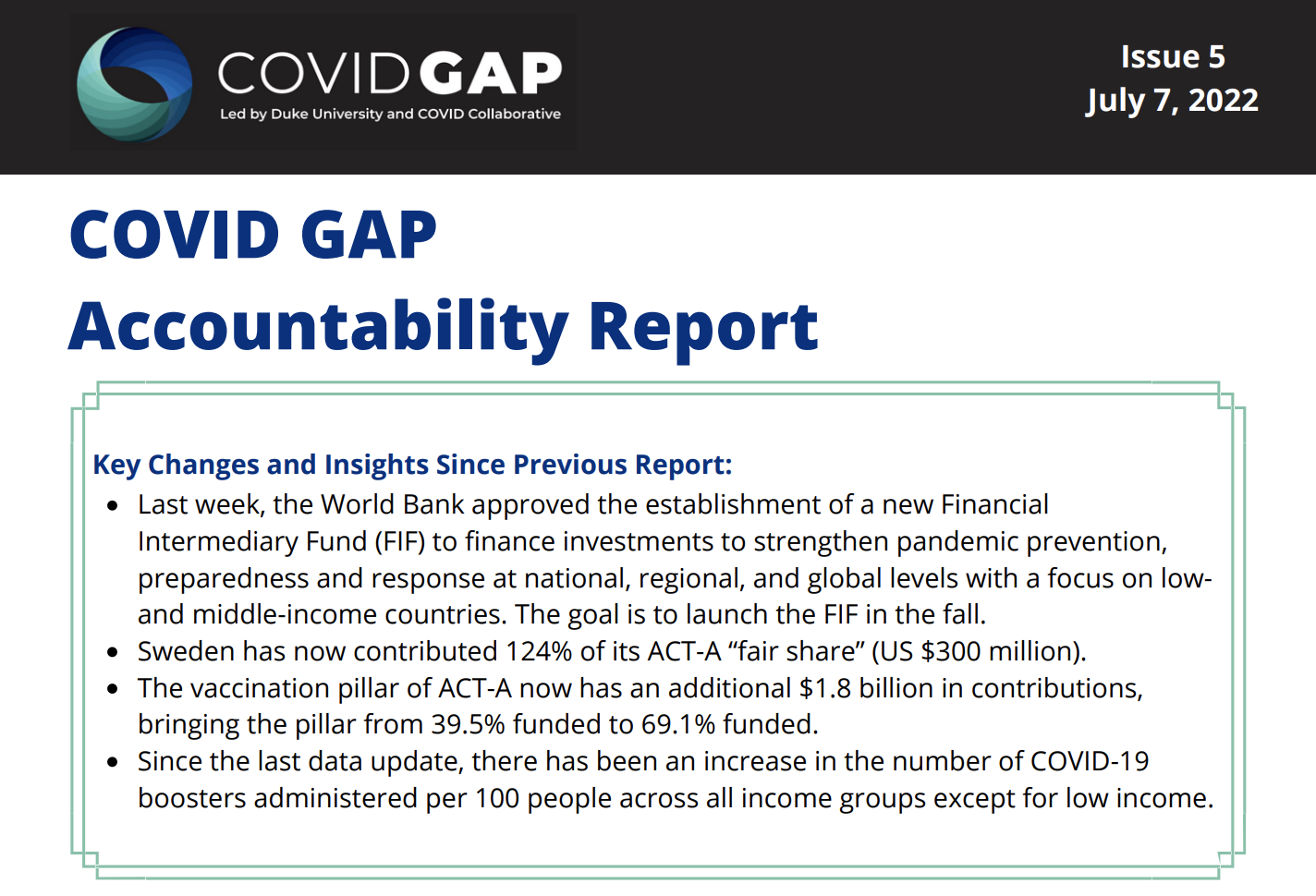
June 23, 2022: COVID GAP Accountability Report Issue 4
Key Changes and Insights Since Previous Report:
Germany has now contributed 115% of its ACT-A “fair share” (US $1.27 billion), becoming the first country to exceed its contribution benchmark set by the ACT-A Facilitation Council’s Finance and Resource Mobilization Working Group.
The health systems pillar of ACT-A now has an additional $231 million in contributions, bringing the pillar from 5.5% funded to 9% funded.
The mid-2022 deadline for the 70% vaccination coverage target, defined as end of June, is fast approaching. With one week to go, 145 countries are still off track to meet the 70% vaccination target.
Since the last data update, Sierra Leone and South Sudan have had the greatest changes in percent of population fully vaccinated and daily vaccination rate, but still modest (e.g., less than 1% change in population fully vaccinated).
June 8, 2022: COVID GAP Accountability Report Issue 3
Key Changes and Insights Since Previous Report:
NEW: COVID GAP is now tracking booster doses administered globally. Based on current data, booster coverage is greatest in high income countries (average of 41 doses administered per 100 people) and lowest in low-income countries (2 doses per 100 people). Continued roll out of primary doses in many lower-income countries may explain some of the difference in booster coverage, however inconsistent booster policies across countries creates an additional challenge to drawing insights from this metric.
Since the last accountability report, no countries have reported updated data to WHO’s COVID-19 Vaccine Delivery Partnership Information Hub, therefore we are unable to report on any progress related to vaccine delivery.
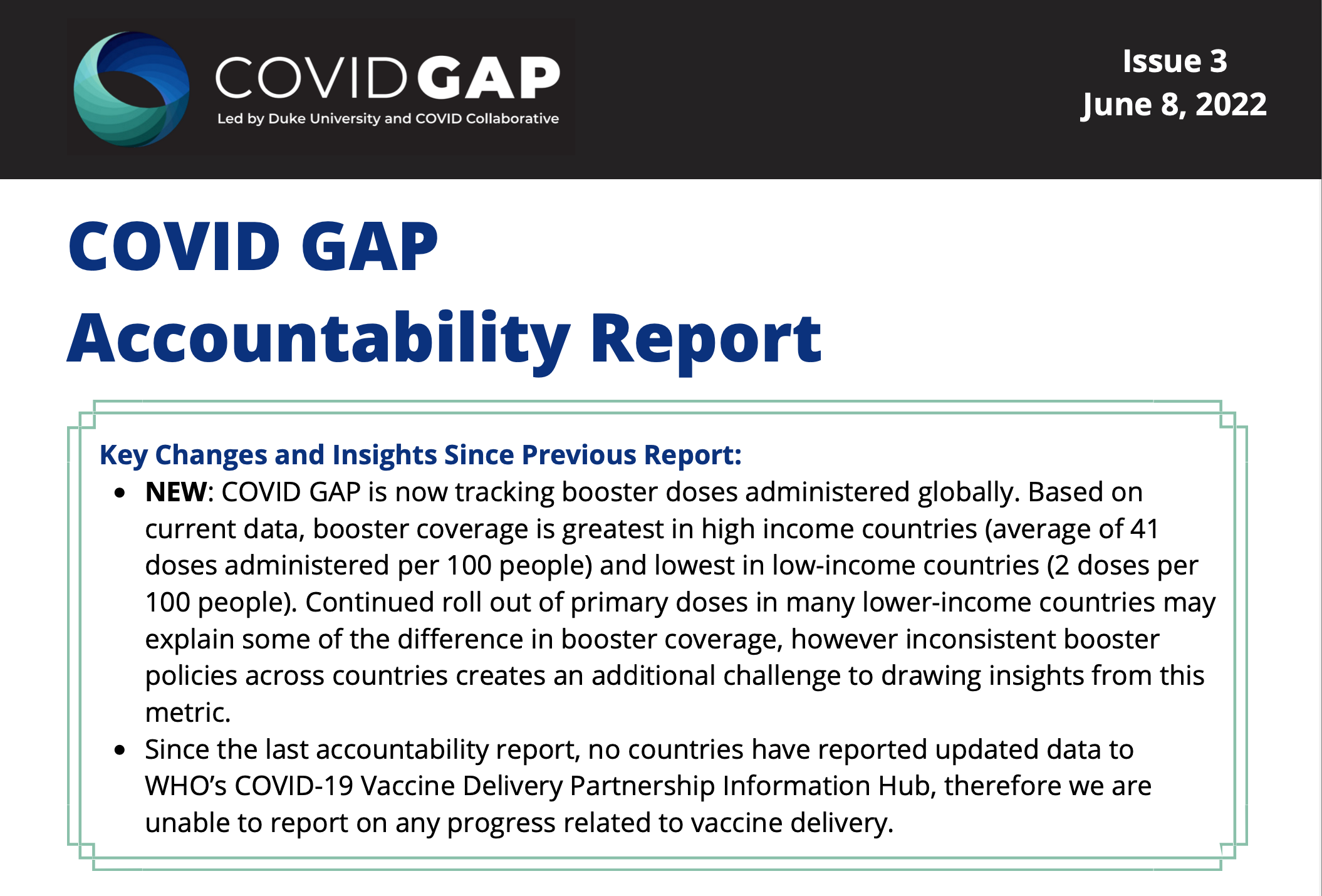
May 25, 2022: COVID GAP Accountability Report Issue 2
COVID Global Accountability Platform’s (COVID GAP’s) Accountability Reports highlight and analyze recent developments, track progress toward national, regional, and global targets, and identify high-priority recommendations for a more effective, efficient, and equitable pandemic response and preparedness. Drawing on data across many sources, our team tracks important measures of progress on commitments and remaining gaps, helping to hold leaders and organizations to account on these actions.
May 11, 2022: COVID GAP Accountability Report Issue 1
The global response to COVID-19 has evolved over the past two years, with some notable achievements balanced by continued challenges. The global pandemic response now faces additional headwinds – along with growing pandemic fatigue and complacency in many high-income countries, the crisis caused by Russia’s invasion of Ukraine is causing a further shift of attention and resources. Though there has been significant progress over the past six months, especially on vaccine supply, much more work remains to be done.

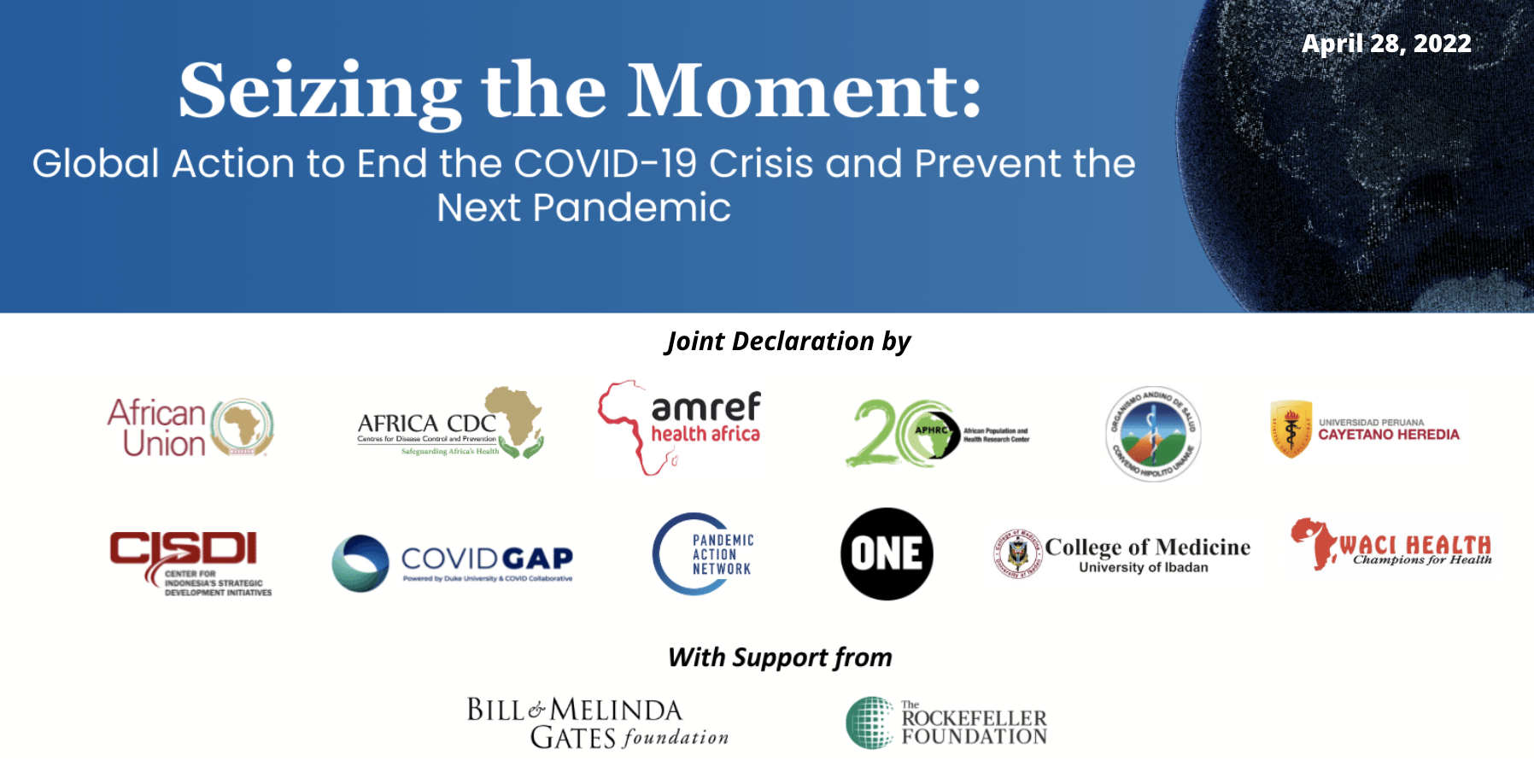
April 28, 2022: Seizing the Moment: Global Action to End the COVID-19 Crisis and Prevent the Next Pandemic
Eleven leading health organizations from around the world released a joint declaration highlighting urgent, actionable priorities to update the post-Omicron COVID-19 strategy for a more equitable and effective global pandemic response. The joint report, Seizing the Moment: Global Action to End the COVID-19 Crisis and Prevent the Next Pandemic, synthesizes the perspectives of diverse speakers — who were joined by over 400 participants from around the world — to identify top priorities to meet global needs at this stage of the pandemic and to build stronger, more resilient, and equitable systems for the future.
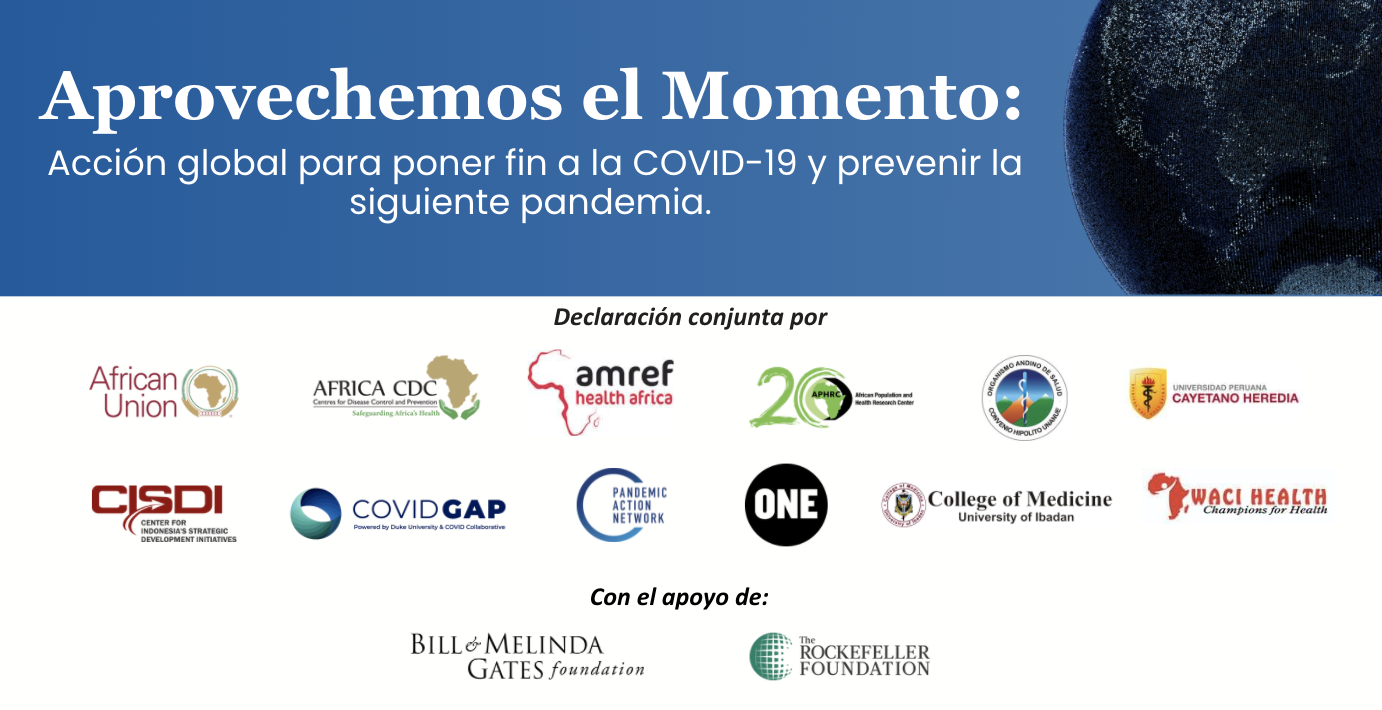
Abril 28, 2022: Aprovechemos el Momento: Acción global para poner fin a la COVID-19 y prevenir la siguiente pandemia
Once organizaciones de salud líderes de todo el mundo publicaron una declaración conjunta que destaca las prioridades urgentes y procesables para actualizar la estrategia post-Omicron COVID-19 para una respuesta global más equitativa y efectiva a la pandemia. El informe conjunto, Aprovechando el momento: Acción global para poner fin a la crisis de COVID-19 y prevenir la próxima pandemia, sintetiza las perspectivas de diversos oradores, a quienes se unieron más de 400 participantes de todo el mundo, para identificar las principales prioridades para satisfacer las necesidades globales. en esta etapa de la pandemia y construir sistemas más fuertes, resilientes y equitativos para el futuro.
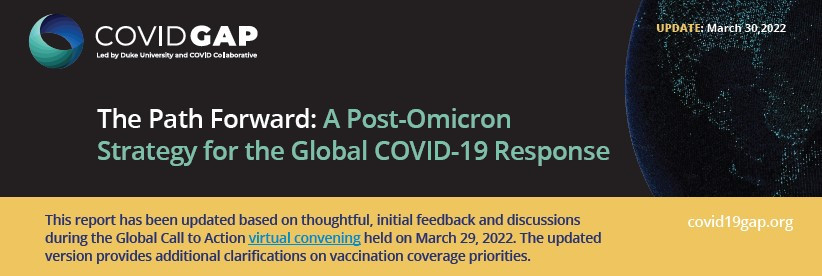
March 30, 2022: The Path Forward: A Post-Omicron Strategy for the Global COVID-19 Response
At this pivotal moment, the world’s response to the pandemic must shift from emergency crisis management to a sustainable control strategy. This strategy should help to build resilient health systems with capabilities to address potential future COVID-19 outbreaks and other public health threats. A new COVID GAP report, The Path Forward: A Post-Omicron Strategy for the Global COVID-19 Response, identifies four actions that can be taken by national leaders, donors, multilateral organizations, and global public health organizations to shift the global strategy.
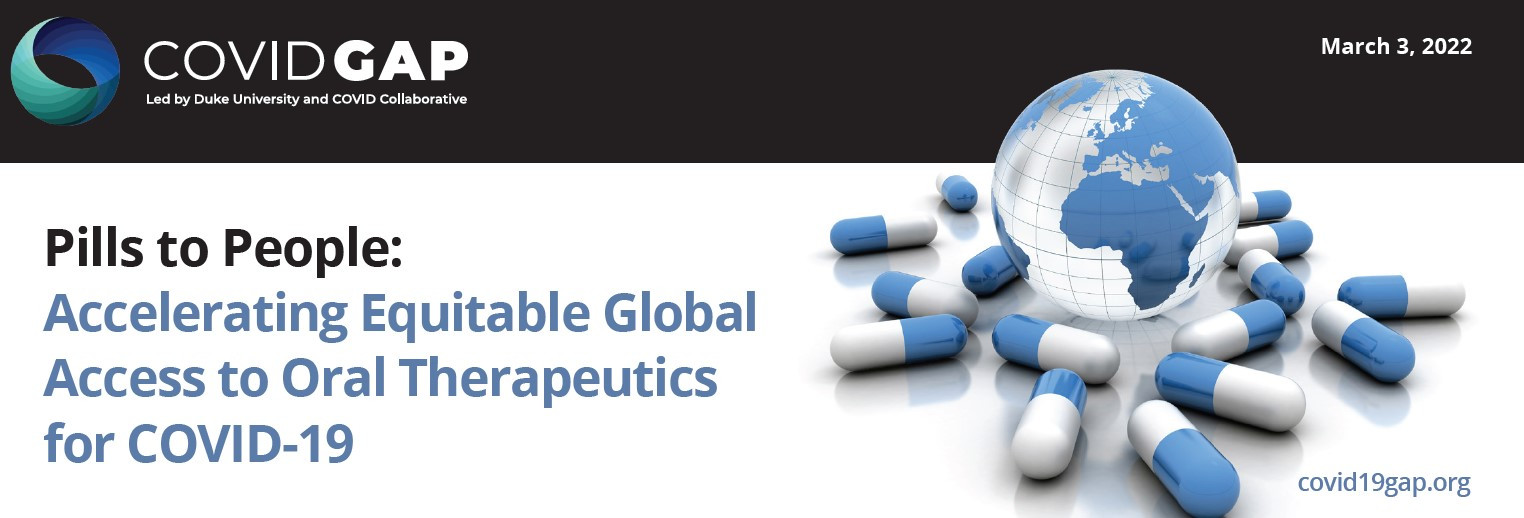
March 3, 2022: While vaccines remain a critical aspect of global pandemic response, COVID GAP emphasizes in its new report, Pills to People: Accelerating Equitable Global Access to Oral Therapeutics for COVID-19, the vital need for a “vaccination plus” strategy that expands the COVID arsenal to include oral treatments.
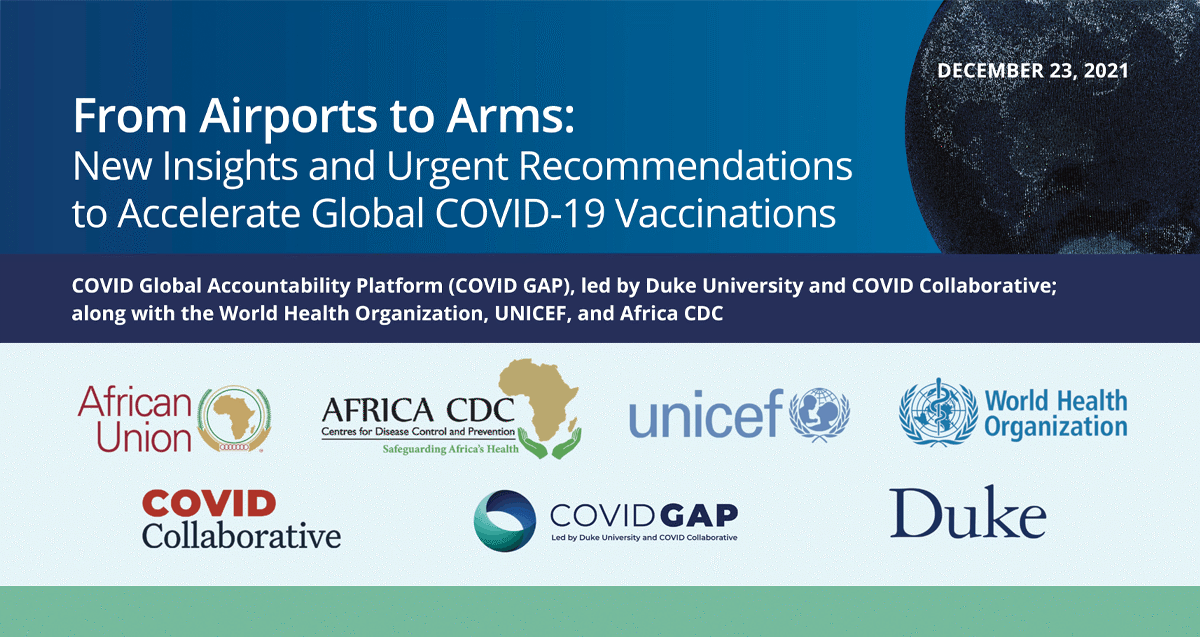
On 13 December 2021, the COVID Global Accountability Platform (COVID GAP, led by Duke University and COVID Collaborative), WHO, United Nations Children’s Fund (UNICEF), and Africa Centres for Disease Control and Prevention (Africa CDC), supported by The Rockefeller Foundation and the Bill & Melinda Gates Foundation, co-hosted a joint global convening on vaccination challenges. This collaboration is bringing together leaders from around the world to co-design and catalyze solutions that can accelerate global pandemic response. This report summarizes insights and recommendations from that convening, and also draws on learnings from national, regional, and global vaccination efforts over the past year, particularly those led by WHO and UNICEF through COVAX Country Readiness and Delivery (CRD) activities and by Africa CDC and the African Union.
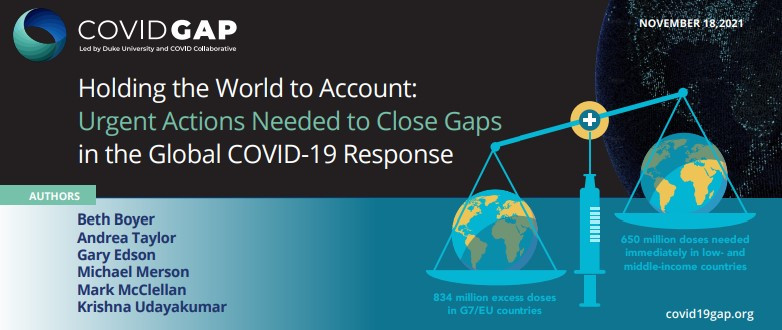
November 18, 2021: This initial report, released by COVID GAP, focuses on steps that the G7/EU countries can take immediately to meet the urgent challenge of reaching 40 percent vaccination coverage in every country by the end of 2021 – a critical milestone to ending the pandemic everywhere.
The COVID GAP Framework
COVID Global Accountability Platform (COVID GAP): Partnering to Establish an Independent Accountability Hub for Global COVID-19 Pandemic Response
Download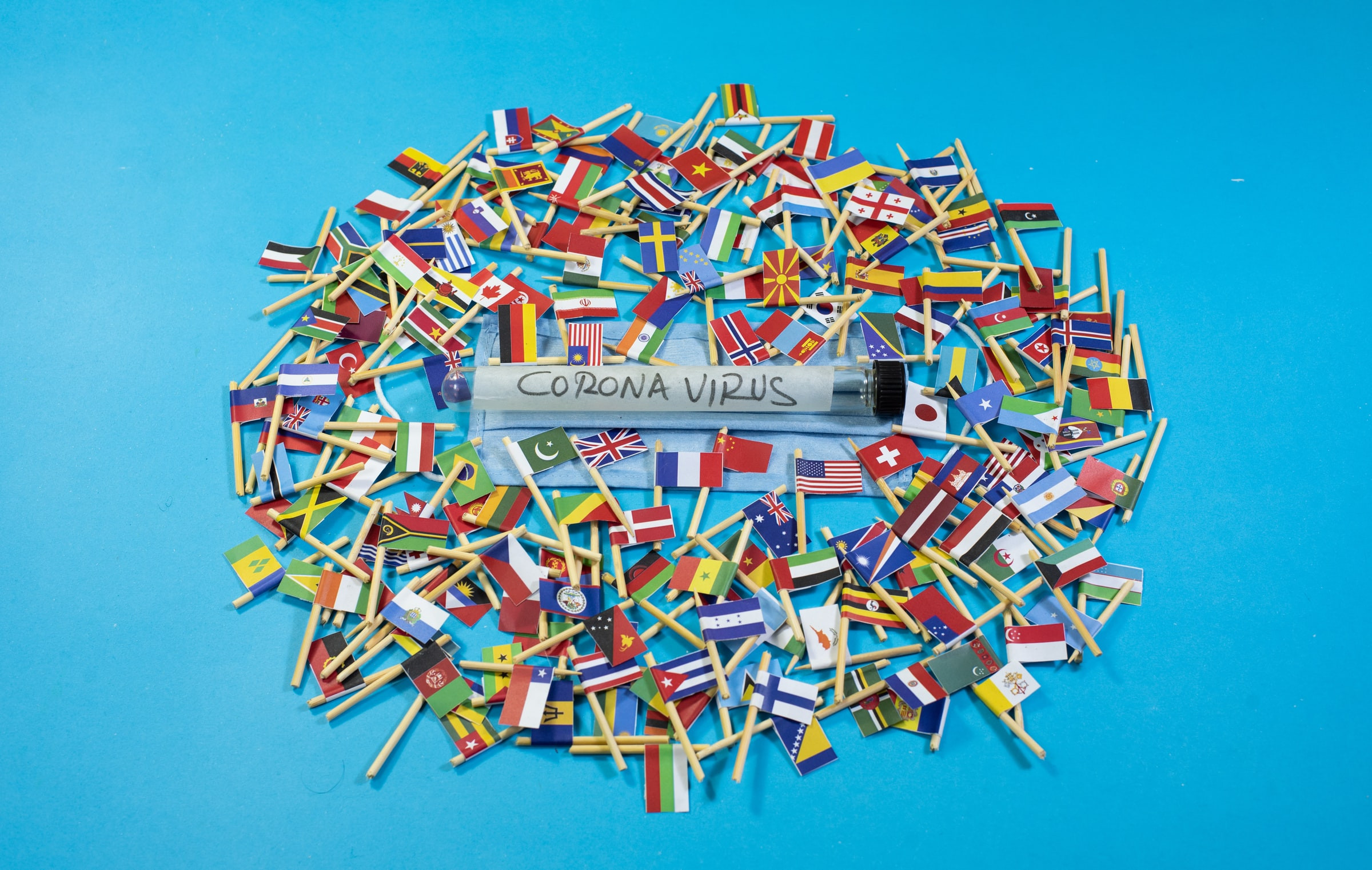
Month by Month: The COVID-19 Global Response Work That Led to COVID GAP
Other Resources, Materials, Publications
August 2022 report from Duke Global Health Innovation Center and GHTC: Navigating complexity to improve global access: Supporting a more efficient and effective World Health Organization Prequalification Program
COVID GAP November 18, 2021 Press Release
Duke Global Health Innovation Center “Launch And Scale Speedometer” For Global Health Interventions
COVID GAP December 22, 2021 Press Release: Convening Summary Released
A Rapid Review of COVID-19 Vaccination Roll-Out
A Rapid Review of COVID-19 Vaccination Roll-Out. A systematic review of COVID-19 vaccine roll-out experiences and lessons learned is being undertaken by the World Health Organization (WHO), the U.S. Agency for International Development (USAID) MOMENTUM Country and Global Leadership project, and COVID GAP, to produce learnings for program audiences at all levels—global, regional, country, and sub-national. This slide deck is the first in a series of multiple rapid review products, highlighting learning, best practices, and recommendations for one of the eight selected themes.

